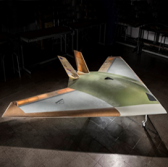 BAE Systems and the University of Manchester have jointly conducted the first phase of flight tests with a small unmanned aerial vehicle that works to maneuver using a blown-air system.
BAE Systems and the University of Manchester have jointly conducted the first phase of flight tests with a small unmanned aerial vehicle that works to maneuver using a blown-air system.
The company said Wednesday that MAGMA UAV’s blown-air system is designed to eliminate the need for mechanical moving parts used to control aircraft during flight, as well as optimize the speed and stealthiness of future military and civil aircraft.
MAGMA is built to feature a wing circulation control system that takes air from the aircraft engine and blasts it supersonically through the wing’s trailing edge to provide aircraft control.
The vehicle also employs a fluidic thrust vectoring technology built to manage aircraft direction by using blown air to deflect the exhaust.
BAE and the University of Manchester plan to perform additional flight trials in the coming months to test MAGMA’s flight control technologies, with a goal to fly the UAV without any moving control surfaces.
The company also works with the University of Arizona and NATO to explore additional technologies that can boost MAGMA’s performance.




